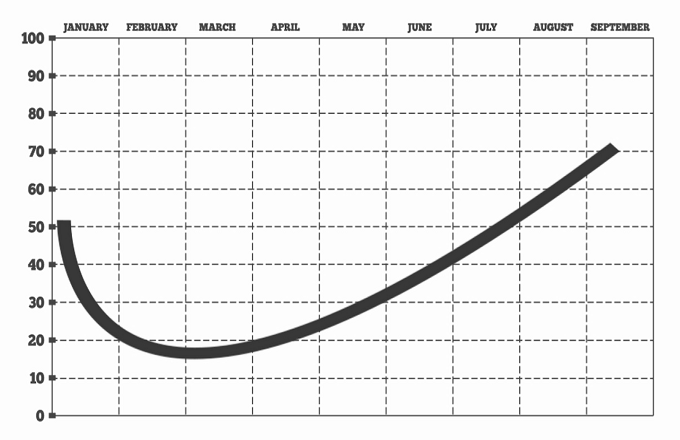Introduction
In the realm of decision-making, understanding the mental models that influence our choices is vital. One such powerful model is the J-Curve. This concept describes a phenomenon where outcomes initially deteriorate before showing significant improvement. Anchored in human psychology, the J-Curve plays a crucial role in our day-to-day lives, impacting personal decisions, business strategies, and public policy-making. In this comprehensive blog post, we will explore the J-Curve as a mental model, its relevance in decision-making processes, and its prevalence in various contexts. Through real-life examples, we will illustrate how individuals or groups, by falling prey to this fallacy, make irrational decisions that hinder their best interests. Additionally, we will delve into the mental biases and psychological underpinnings that contribute to the J-Curve, offering practical strategies to identify and avoid succumbing to this bias. By cultivating awareness and actively avoiding this mental trap, we can enhance our decision-making and achieve more favorable outcomes.
Defining the J-Curve
The J-Curve is a mental model that describes a pattern where outcomes initially worsen or decline before rebounding and experiencing significant improvement. This curve takes the shape of a “J” when plotted over time. It signifies a temporary setback or decline before reaching a higher level than the starting point.
Relevance in Decision-Making Processes
The J-Curve is relevant in decision-making processes where short-term sacrifices or setbacks lead to long-term gains. It recognizes the importance of perseverance and enduring initial challenges to achieve desired outcomes. Understanding this model helps decision-makers avoid premature judgment and short-sighted decisions that may hinder long-term success.
Prevalence of the J-Curve in Our Lives
The J-Curve manifests in various aspects of our lives. Let’s explore three distinct examples to illustrate its occurrence
- Personal Life Decisions: Consider an individual embarking on a fitness journey. Initially, they may experience physical discomfort, muscle soreness, and a temporary decline in performance. However, by persisting with regular exercise and a healthy lifestyle, their fitness level gradually improves, surpassing their initial state. Without recognizing the J-Curve, individuals may become demotivated and abandon their fitness goals prematurely, missing out on the long-term benefits.
- Business Scenarios: In the business world, the J-Curve often applies to new ventures or product launches. For instance, a startup may experience financial losses and low market adoption in its early stages. However, with continuous improvements, customer feedback, and strategic adjustments, the business can eventually surpass its initial setbacks and achieve substantial growth. Failing to acknowledge the J-Curve may lead entrepreneurs to abandon promising ventures prematurely, missing out on the potential for long-term success.
- Public Policy-Making: The J-Curve can also be observed in public policy decisions, particularly in areas such as education or infrastructure development. Implementing significant reforms or investments may incur initial costs or disruptions. However, over time, these efforts can lead to improved educational outcomes or enhanced infrastructure, benefiting society in the long run. Disregarding the J-Curve may result in policymakers favoring short-term solutions over long-term progress.
Mental Biases and Psychological Underpinnings
Several mental biases contribute to the disregard of the J-Curve. The Availability Heuristic, for example, leads individuals to rely on readily available information when making judgments. If the available information reflects the temporary decline or setbacks of the J-Curve, individuals may underestimate the potential for long-term gains and make hasty decisions based on short-term setbacks.
Moreover, the Loss Aversion bias plays a role in individuals’ aversion to initial losses or setbacks. People tend to place more weight on avoiding losses than on achieving gains. This bias can prevent individuals from persisting through the initial dip of the J-Curve and cause them to abandon their efforts prematurely.
Avoiding the J-Curve Trap
To avoid falling prey to the fallacies of the J-Curve, consider the following strategies
- Understand the concept: Familiarize yourself with the J-Curve model and its prevalence in decision-making. Recognize that short-term setbacks are often a part of a larger growth trajectory.
- Set realistic expectations: Understand that progress takes time, and initial setbacks or declines may be temporary. Maintain a long-term perspective and avoid making hasty judgments based on short-term outcomes.
- Focus on the process: Instead of solely fixating on immediate results, shift your focus to the actions and strategies that contribute to long-term success. Emphasize consistent effort, continuous learning, and adaptation.
- Seek support and guidance: Surround yourself with mentors, coaches, or a supportive network that can provide guidance and encouragement during challenging times. Their insights and experiences can help you navigate the J-Curve more effectively.
Conclusion
The J-Curve mental model highlights the temporary setbacks and subsequent long-term gains in decision-making processes. By understanding its principles and avoiding associated biases, decision-makers can make more informed and resilient choices. Embracing the J-Curve empowers individuals and groups to endure initial challenges, persevere through setbacks, and unlock the potential for long-term success. Cultivating awareness and actively avoiding the fallacies of the J-Curve enhance our ability to make objective judgments and ultimately lead to more favorable outcomes.
